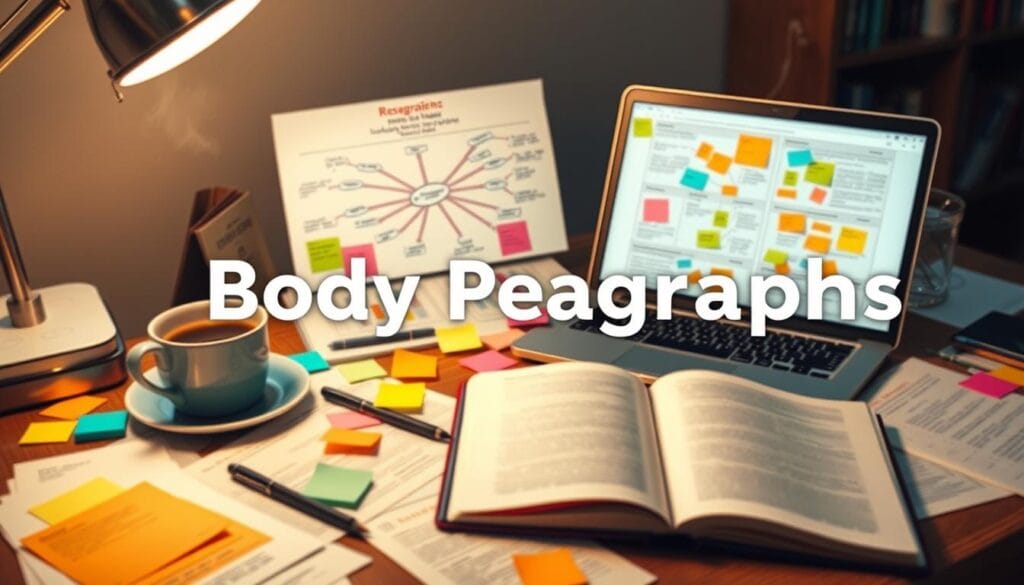“The greatest enemy of knowledge is not ignorance, it is the illusion of knowledge.” This profound quote by Stephen Hawking echoes in today’s educational scene. The rise of artificial intelligence, such as ChatGPT, is changing how students write essays. As technology advances, it’s vital to know how to use ChatGPT without plagiarizing. Students are now using AI tools like ChatGPT for essay writing help1.
This technology aids in generating ideas, structuring essays, and enhancing writing quality. However, it also poses challenges to originality and academic integrity.
To master ChatGPT for academic writing, understanding plagiarism, setting up the tool, and using it as a collaborative aid is key. This approach not only boosts learning outcomes but also empowers diverse learners. It also helps reduce risks linked to AI overuse2. This article will guide you on how to write original essays with ChatGPT. You’ll learn to express your thoughts uniquely, reflecting personal insights while adhering to academic standards.
Key Takeaways
- Understanding plagiarism is crucial when leveraging AI tools like ChatGPT.
- Students increasingly assist their writing processes through AI, raising concerns about originality.
- Effective use of ChatGPT requires clear strategies to avoid accidental plagiarism.
- AI can significantly improve educational accessibility and equity but comes with risks.
- ChatGPT should be seen as a writing aid rather than a replacement for personal knowledge.
Understanding Plagiarism in Essay Writing
Plagiarism is a critical issue in essay writing. It involves using someone else’s work or ideas without giving credit. This can lead to severe consequences, including academic penalties, damage to reputation, and loss of trust. It’s essential to understand what plagiarism entails.
What Constitutes Plagiarism?
Plagiarism takes many forms, such as direct copying, paraphrasing without credit, or self-plagiarism. Direct copying means copying someone’s work exactly. Paraphrasing without credit is also plagiarism if it expresses another’s ideas in one’s own words. Both carry significant risks, especially in academia, where honesty is crucial.
Different Types of Plagiarism
Knowing the various types of plagiarism helps protect one’s work. There’s complete plagiarism, where someone submits another’s work as their own. Partial plagiarism involves taking parts from different sources without attribution. Mosaic plagiarism combines bits of texts without proper citation. The rise of AI-generated content raises new concerns about originality and plagiarism in such content34.
Consequences of Plagiarism
The effects of plagiarism can be severe. Schools often impose strict penalties, from failing grades to expulsion. Plagiarism not only harms the educational system but also damages one’s credibility and reputation. With AI tools like ChatGPT becoming more common, understanding plagiarism’s consequences is more important than ever3.
Overview of ChatGPT

ChatGPT marks a major leap in artificial intelligence, offering a powerful tool for writing tasks. It includes essay writing and academic writing. Developed by OpenAI, this AI model excels in creating coherent, contextually relevant text from user prompts.
What is ChatGPT?
ChatGPT is an advanced AI designed to generate human-like text. It uses complex machine learning to tackle a broad range of topics. This makes it invaluable for students and writers, offering insights and enhancing content creation.
How ChatGPT Works
ChatGPT operates on the Transformer architecture, allowing it to grasp language patterns well. Users can engage with it in real-time, seeking specific content or writing help. For crafting essays, ChatGPT aims to cut down initial drafting time, typically between 3 to 5 hours5.
Variants of ChatGPT Available
There are several ChatGPT variants, each with unique features for different writing needs. These range from basic text generation to more complex functions like tailored feedback and academic requirements. Users can expect clear, error-reduced text, similar to human writing5.
Setting Up ChatGPT for Essay Writing
To harness the power of artificial intelligence for essay writing, setting up ChatGPT is essential. This involves creating an account on the OpenAI platform. This step is crucial for accessing its features and capabilities.
Creating an Account
Creating an account on the OpenAI platform is simple. It’s important to provide accurate information during registration. This ensures smooth access in the future. After registration, a verification step is required. This confirms the user’s identity.
Familiarizing with the Interface
With an active account, understanding the interface is key. The layout is intuitive, making navigation easy. Knowing the available features boosts efficiency in using ChatGPT for essays.
Exploring the interface is vital for optimal performance. This aligns with effective ChatGPT essay writing tips. It ensures a good grasp of prompt input.
Choosing the Right Version
Choosing the right ChatGPT version is critical based on writing needs. Different versions have varied capabilities. Understanding which version meets your needs can greatly improve the writing process.
For instance, some versions are better suited for complex tasks. Others excel in generating straightforward content.
Brainstorming Essay Topics with ChatGPT

ChatGPT is a valuable tool for generating essay topics, offering a wide range of options based on your interests. This initial step boosts creativity and streamlines the brainstorming process.
Generating Ideas
Users can explore numerous essay topics with ChatGPT, making brainstorming more efficient. ChatGPT helps refine and evolve thesis statements, allowing writers to concentrate on the essay’s core aspects6. This feature saves time on topic selection and encourages more engaging essay writing.
Refining Topic Suggestions
After generating ideas, users can refine these suggestions with targeted prompts. By adjusting parameters, you can narrow down to more specific themes, ensuring they are relevant and well-supported by resources7. This approach ensures topics meet academic standards, enhancing essay quality.
Evaluating Topic Viability
Evaluating topic viability is crucial. Writers should consider scope, relevance, and resource availability when choosing a topic. Effective assessments lead to well-structured essays that present arguments clearly6. This makes writing with ChatGPT productive and enriching.
Crafting an Outline Using ChatGPT
Creating a well-organized outline is crucial for any successful essay. It acts as a blueprint, guiding the writer through key points and arguments. A clear outline improves the essay’s structure, enhancing both logical flow and coherence.
Benefits of an Essay Outline
An essay outline offers many benefits. It clarifies the essential elements to cover, ensuring nothing important is missed. A structured approach boosts writing effectiveness, allowing for logical thought formulation. This improves critical thinking and clear communication skills, essential in various professional fields3.
Moreover, a well-structured outline is the foundation of a strong essay. It provides direction for the writing process6.
How to Create an Outline
To create an effective outline, start by defining the thesis statement. This is a critical element in essay writing6. Identifying the central argument helps break down main points and sub-points that support the thesis. Organizing these elements in a logical order creates a strong essay framework.
Using ChatGPT to Organize Ideas
ChatGPT can greatly assist in outlining. By using its capabilities, users can generate structured outlines for specific topics and suggested main points3. This technology aids in brainstorming and refining ideas, ensuring a comprehensive approach to organizing thoughts6. Thus, using ChatGPT for academic writing can make the process more efficient and less cumbersome.
Researching for Your Essay with ChatGPT

Effective research is key to writing a compelling essay. ChatGPT offers a valuable tool for students to quickly gather relevant information. It can generate engaging article ideas and titles, providing multiple angles for essay writing8. To get the most out of this AI tool, adopting effective research tips is crucial.
Tips for Effective Research
Students should ensure their prompts are clear when using ChatGPT for research. This clarity leads to more precise answers relevant to their essay topics. Filtering and refining the AI’s responses also improves outcomes. This method helps build a solid foundation of ideas and enhances critical thinking skills9.
Validating Information Sources
While ChatGPT can generate content, validating information sources is essential. Students must cross-check facts and statistics against credible sources to ensure accuracy10. Relying solely on AI can lead to inaccuracies. Therefore, fact-checking the information provided by ChatGPT is critical.
Integrating Research into ChatGPT
Integrating well-researched material into ChatGPT’s suggestions enhances essay quality. The platform can refine writing by editing drafts and adjusting tone and structure. Adding personal insights can further enrich the content. This approach promotes originality and minimizes plagiarism detection risks8
Writing the Introduction with ChatGPT

The introduction is the first thing readers see, setting the tone for the rest of the essay. ChatGPT can help by offering examples and ideas. Knowing what makes a good introduction is key.
Key Elements of an Introduction
A good introduction includes background, a hook, and a thesis statement. The thesis statement is crucial, outlining the main argument. It guides the essay’s direction. Crafting a strong introduction can be tough, but ChatGPT offers support.
Generating Introductory Statements
ChatGPT makes writing introductory statements easier. It creates engaging paragraphs that grab attention and provide context. Using ChatGPT helps students avoid common mistakes and keeps their introduction focused, improving their essay’s quality7.
Making a Strong Thesis Statement
A strong thesis statement is essential for defining the essay’s focus and argument. ChatGPT helps refine these statements, making them clear and debatable. Collaborating with ChatGPT enhances understanding of thesis statements, leading to a more impactful introduction37.
Developing Body Paragraphs with ChatGPT

Creating effective body paragraphs is key to presenting arguments and supporting ideas in essays. It involves structuring sentences for clarity and detail. ChatGPT aids in this process, offering insights to enhance writing skills.
Structuring Body Paragraphs
Each paragraph should begin with a clear topic sentence. This sentence outlines the main idea. Then, add supporting details and evidence to bolster the argument. ChatGPT helps organize these elements, ensuring each paragraph stays focused and coherent.
Techniques for Coherence and Flow
Using transitional phrases and logical connections is vital for coherence. ChatGPT suggests effective transitions, guiding readers through ideas smoothly. This improves the essay’s flow, making it more engaging to read.
Incorporating Evidence and Examples
ChatGPT helps writers support their claims with evidence. It generates relevant examples and suggests proper citation methods to avoid plagiarism. Including statistics and credible references strengthens arguments, demonstrating the essay’s solid foundation1112.
Writing the Conclusion with ChatGPT

A strong conclusion is your last chance to solidify your main arguments and conclude your essay. The importance of a conclusion is immense; it distills the insights from your writing journey and underscores the significance of your findings. ChatGPT can be a valuable tool in crafting this crucial section, ensuring readers grasp the essay’s core themes.
Importance of a Strong Conclusion
Conclusions are vital for summarizing the essay’s key points. They offer a chance to reflect on your arguments and make a lasting impression. This final statement can motivate readers to ponder the topic’s implications. ChatGPT can assist in this endeavor, providing structured prompts and suggestions.
Summarizing Key Points
Creating a compelling conclusion involves summarizing key points from your essay’s body. This reinforces your thesis and highlights the main arguments. Using ChatGPT can make this process smoother, ensuring your essay’s core elements are captured and emphasized.
Leaving a Lasting Impression
A well-crafted conclusion should leave a lasting impact on the reader. It should emphasize the broader implications of your arguments and encourage reflection. ChatGPT can aid in crafting impactful conclusions, enhancing your essay’s quality. It promotes originality and critical thinking, reducing plagiarism risks and fostering intellectual engagement.
Editing and Revising with ChatGPT

Editing and revising an essay are key steps to a polished final draft. ChatGPT makes this process easier. Editing is crucial for clarity, coherence, and quality in writing.
Importance of Editing
Thorough editing boosts essay readability and structure. It corrects grammar and refines vocabulary, making arguments stronger. Reading the text aloud helps spot awkward phrasing and areas for improvement.
Tools within ChatGPT for Proofreading
ChatGPT has features for effective editing. It suggests grammatical corrections and offers instant feedback. This AI uses vast data to understand language and style13. Yet, users should watch for potential limitations, as accuracy depends on prompt quality14.
Tips for Effective Revision
Using editing tools is just part of the process. Systematic revision strategies are essential. Break editing into sections and focus on one aspect at a time.
External feedback is also valuable. Working with peers or professional services enhances quality and ensures academic standards. ChatGPT can help overcome writer’s block, making revision less daunting.
Ensuring Originality in Your Essay

Originality is key in academic writing. It’s about distinguishing one’s unique voice and ideas from others. Students must understand what makes work original to avoid plagiarism penalties and loss of credibility15.
Understanding Originality in Writing
Originality means authenticity in writing, highlighting the need for unique language and perspective. By creating personal ideas and integrating them, writers boost their creativity and respect others’ intellectual property. Through research and critical thinking, students can express their arguments uniquely, emphasizing the importance of originality in essays.
Tools to Check for Plagiarism
Checking for plagiarism is essential. Tools like Turnitin and Grammarly Premium are effective in detecting similarities. They provide detailed reports, guiding students to revise and ensure originality16.
Best Practices for Maintaining Originality
To maintain originality, following best practices is vital. Students should paraphrase content to fit their style and attribute sources when needed. Adding personal insights and examples to AI-generated content makes essays unique. This method reduces plagiarism risk and promotes genuine academic expression15.
Utilizing ChatGPT for Feedback

Using ChatGPT for feedback can greatly improve a student’s writing. It offers insights into their essay’s strengths and weaknesses. This starts with asking for feedback, where students can get ChatGPT’s opinion on clarity and argument strength.
How to Request Feedback
To get the most out of feedback, students should clearly state what they want evaluated. They can ask about their arguments or writing style. ChatGPT provides detailed feedback, helping students navigate this stage.
Interpreting the Feedback
Understanding feedback is key. Students need to critically analyze ChatGPT’s insights. They should look for recurring themes or suggestions for improvement. Grasping the feedback’s nuances can lead to significant improvements in their writing.
Revising Based on Feedback
Revising based on feedback can make an essay stronger. Students can use ChatGPT’s suggestions to enhance their arguments and clarity. This process not only boosts the essay’s quality but also helps students learn effective writing techniques1718.
Ethical Considerations of Using AI

The integration of artificial intelligence into academic writing raises significant ethical concerns. The use of AI in writing sparks debates on authorship and originality. Studies show plagiarism, linked to AI tools like ChatGPT, is a growing issue. Reports indicate a high awareness of ethical standards in this context19.
The Role of AI in Academic Writing
AI technology is transforming academic writing, but it also raises questions about accuracy and bias. Over half (62%) of urologists have expressed ethical concerns about using tools like ChatGPT in their writing20. The development of AI algorithms often involves using content without consent, creating ethical dilemmas about ownership and originality19.
Navigating Ethical Boundaries
It’s crucial to maintain ethical standards when using AI for academic purposes. The risk of AI-generated content containing plagiarized phrases is significant, given the data sources for models like ChatGPT21. As academic writing evolves, the importance of human oversight becomes clearer. Human writers add unique perspectives and insights that AI cannot replicate21.
Maintaining Academic Integrity
Academic integrity is paramount in educational settings. Using AI responsibly means ensuring the output is authentic and transparent. The World Health Organization’s warnings about AI in healthcare apply similarly to academic environments20. Legal consequences could follow for authors and brands if AI-generated content is plagiarized, highlighting the need for caution21.
Tips for Effective ChatGPT Usage

To use ChatGPT effectively, understanding how to interact with it is key. Students should give clear, specific prompts to get the most out of their questions. Best practices for ChatGPT involve recognizing its strengths in creating structured essays. It’s also important to be aware of its limitations.
Best Practices for Prompting ChatGPT
Clear prompts lead to better responses from ChatGPT. It can handle a wide range of topics well and provide relevant outputs. The model is trained on vast internet text, making it adept at various subjects22.
Students should add personal experiences to their writing. This adds depth and originality, helping to avoid plagiarism. It also enriches the academic voice in their work17.
Utilizing Features for Enhanced Writing
ChatGPT has many features to improve writing, like text generation and vocabulary expansion14. Students can brainstorm, outline, and even craft thesis statements with these tools. Using ChatGPT as a support tool deepens topic exploration, aiding in research and enhancing essay content22.
Learning from Iteration
Students should embrace the iterative process with ChatGPT. Reviewing and revising content helps refine prompts and adjust based on initial results. This cycle of learning from iteration improves academic work quality. It ensures students keep their unique perspectives, avoiding AI-reliant writing pitfalls17.
Finalizing Your Essay
Finalizing your essay is a critical phase that integrates formatting, citations, and last-minute checks to ensure academic integrity. Proper formatting and citations, as per the required style guide such as APA, MLA, or Chicago, are vital. They present the essay professionally. It’s crucial to maintain consistency and clarity throughout, especially in the reference list formatting. Tools like ChatGPT can help with specific styles, including APA 7th23.
Formatting and Citations
The first step in finalizing your essay involves formatting and citations. Students should verify that all sources are cited correctly and formatted according to the chosen style guide. ChatGPT can aid in generating a formatted reference list. However, one must always fact-check the information provided, as the tool has a high level of inaccuracies23. It’s advisable to ask ChatGPT for a source for any presented facts or statistics to ensure reliability23.
Last-Minute Checks
Once formatting is complete, conducting last-minute checks for grammar, coherence, and structure is essential. Tools like ChatGPT can assist in proofreading but rely on user requests to ensure proofreading is in American English and follows the APA 7th style guides23. Engaging with expert assistance can be beneficial after leveraging ChatGPT to confirm references, grammar, and tone. This ensures nothing slips through the cracks23.
Submitting Your Essay Responsibly
After ensuring every aspect of the essay is polished, the final step is submitting your essay responsibly. Students must be mindful of academic standards and institutional policies regarding submission formats and timelines. Given the risks associated with using generative AI tools like ChatGPT, students should be prepared to defend their research and writing choices. Responsible submission reflects their effort and integrity23.
FAQ
How can I use ChatGPT to write an essay without plagiarizing?
What are the consequences of committing plagiarism in academic writing?
What is ChatGPT and how does it work?
How do I set up ChatGPT for my essay writing?
Can ChatGPT help in brainstorming essay topics?
How can I create an outline for my essay using ChatGPT?
Is it possible to conduct effective research with ChatGPT?
What should I include in the introduction of my essay?
How can ChatGPT assist with writing body paragraphs?
What are the key components of a strong conclusion?
How can I edit and revise my essay using ChatGPT?
What tools can I use to check for plagiarism?
How can ChatGPT be utilized for obtaining feedback?
What ethical considerations should I keep in mind when using AI for academic writing?
What are some tips for effectively using ChatGPT?
What is involved in finalizing my essay?
Source Links
- How to Use ChatGPT to Write an Essay Without Plagiarizing?
- How to Use ChatGPT to Write an Essay – Avoid Plagiarizing with These Tips
- Should I Use ChatGPT to Write My Essays? – Harvard Summer School
- Does ChatGPT Plagiarize Content?
- How to Use ChatGPT to Write an Essay | CustomWritings.com™ Blog
- How to Use ChatGPT to Write an Essay – Cabina AI
- ▷ Writing an Essay with ChatGPT ≡ Step-by-Step Guidance
- How to Use ChatGPT as an Essay Writer – Unlimited Graphic Design Service
- How to Use ChatGPT for Research and Essays
- Students: Using ChatGPT Without Plagiarism, Part 1
- Master Essay Writing with These 10 ChatGPT Prompts
- How To Use ChatGPT To Write An Essay (Complete Guide)
- How to Use ChatGPT to Write an Essay: Examples and Tips
- Learn How to Use ChatGPT in Essay Writing Ethically
- How to Avoid Plagiarism While Using ChatGPT and AI Chatbots (2025) – GeeksforGeeks
- EssayGenius AI Essay Writer
- My Best Ideas to Prevent Cheating with Chat GPT + How to Handle Plagiarism Suspects
- Can I Use ChatGPT to Edit My Essays If I Write Them from Scratch?
- The Ethics of ChatGPT Essay Writing — Is It Plagiarism?
- Ethical Dilemmas in Using AI for Academic Writing and an Example Framework for Peer Review in Nephrology Academia: A Narrative Review
- Is It Plagiarism To Use AI-Generated Content? The Ethics of Content Creation in an AI World
- Can You Use ChatGPT for College Essays? –
- How to Write Your Essay Using ChatGPT | Proofed’s Writing Tips






